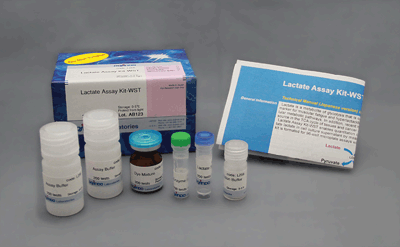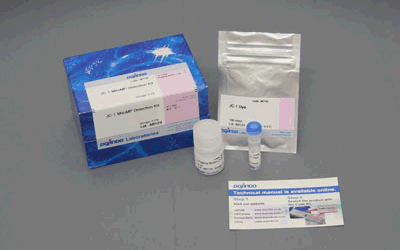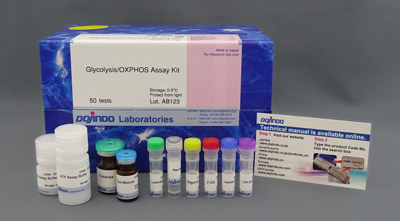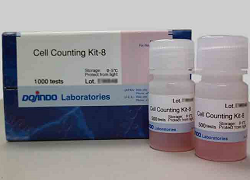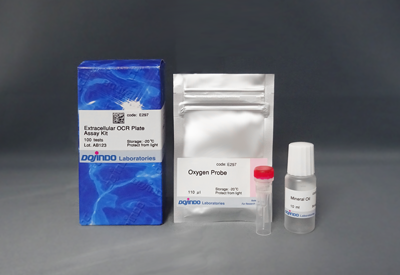Glycolysis/JC-1 MitoMP Assay Kit
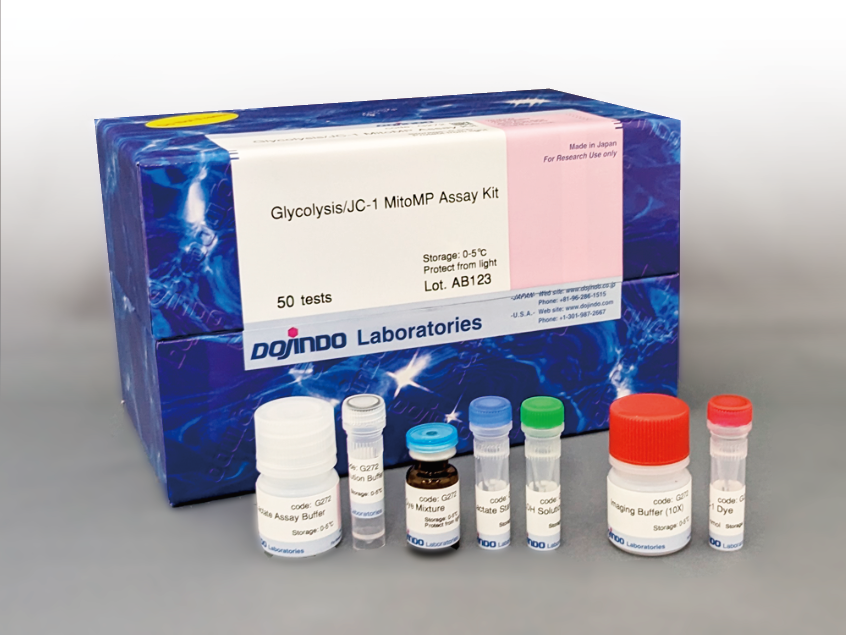
Glycolysis/Mitochondria Membrane Potential Assay
- Two indicators (lactate production and mitochondrial membrane potential) can be measured in one sample
- All reagent acquired is included, ready to use kit
- Easy-to-understand detailed protocol
-
Product codeG272 Glycolysis/JC-1 MitoMP Assay Kit
| Unit size | Price | Item Code |
|---|---|---|
| 50 tests | Find your distributors | G272-10 |
| 50 tests | ・Dye Mixture ・Lactate Standard ・LDH Solution ・Lactate Assay Buffer ・Reconstitution Buffer ・JC-1 Dye ・Imaging Buffer (10X) |
×1 150 µl×1 12 µl×1 5.5 ml×1 550 µl×1 ×1 6 ml×1 |
|---|
Description
The link between mitochondrial function and cellular metabolism is well-known, with implications for a range of diseases including cancer, aging, and neurodegenerative diseases. It has been found that aging cells often rely on the glycolytic system for survival, rather than drawing on mitochondrial energy sources. Conversely, cancer cells, which typically depend heavily on glycolysis, activate mitochondrial function to ensure their survival even when the glycolytic system is inhibited. Given these observations, there is a growing necessity to investigate both mitochondrial function and the glycolytic pathway to enhance our understanding of intracellular metabolic alterations. Our kit allows for the measurement of lactate production (via a lactate assay) to detect changes in the glycolytic system, as well as the mitochondrial membrane potential (via a JC-1 assay) to assess mitochondrial function. The concept of this kit is to provide a comprehensive, one-stop assay from the same sample to track changes in intracellular metabolism and guide subsequent, more detailed analyses. The kit includes all necessary reagents for the assays, and a combined protocol is also available.
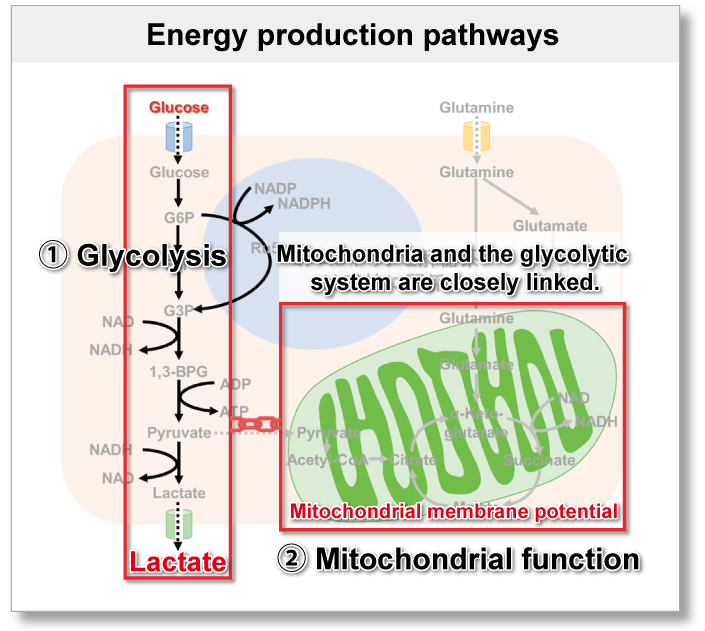
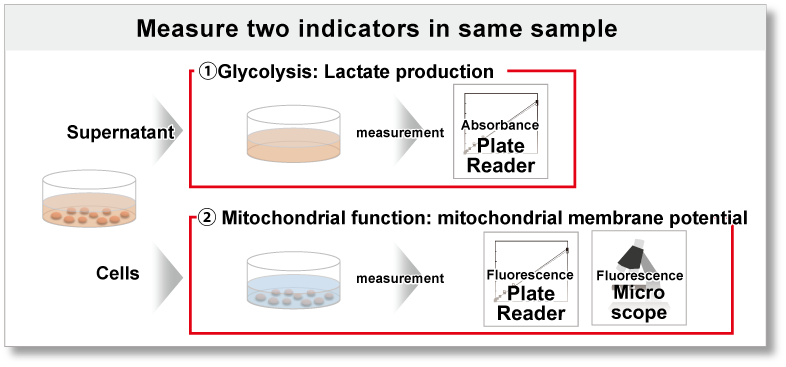
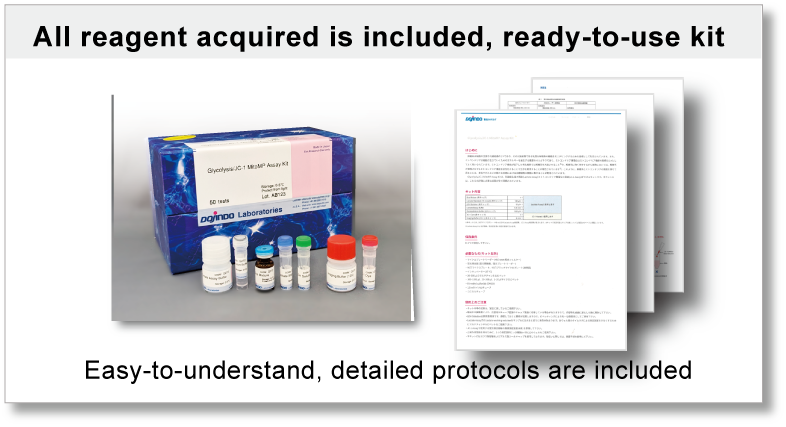
Manual
Technical info
The kit includes a Lactate Assay Kit, designed to detect lactate production in cell culture medium through the measurement of WST formazan absorbance. Additionally, it features JC-1 dye, which is used to detect mitochondrial membrane potential within cells using fluorescence measurement. Both of these targets can be effortlessly quantified using a plate reader on the same sample, facilitating the evaluation of metabolic changes.
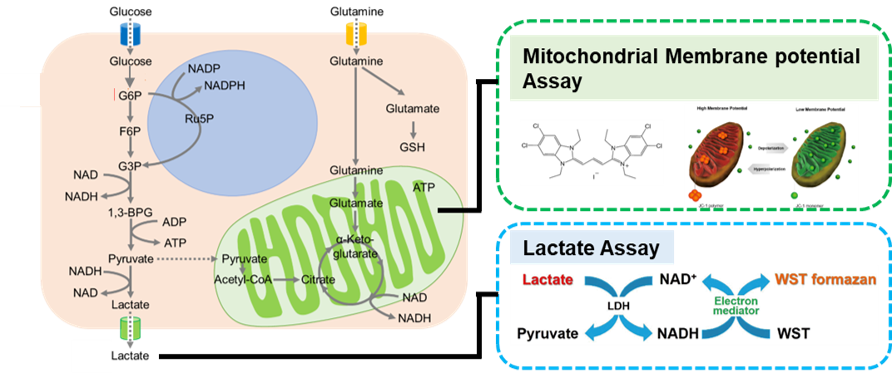
What can be evaluated with this kit
Intracellular metabolic changes caused by any stimulations can be detected by measuring lactate production and mitochondrial membrane potential.
In certain instances, cells manage to survive despite sustaining damage to their glycolytic system or mitochondrial function, the principal pathways for energy production. It is understood that this occurs as cells strive to persist and prevent cell death by augmenting glycolysis even when mitochondrial function is compromised, or by activating mitochondrial function when glycolysis is impaired. Simultaneously monitoring both the glycolytic system and mitochondrial function, as detailed below, can gain insight into what is happening inside the cell.

Simultaneous measurement of the same sample
By separating the supernatant and cells from a single sample, the mitochondrial membrane potential (JC-1 Assay) and lactate production can be measured together. Detailed measurement methods are described in the instruction manual.
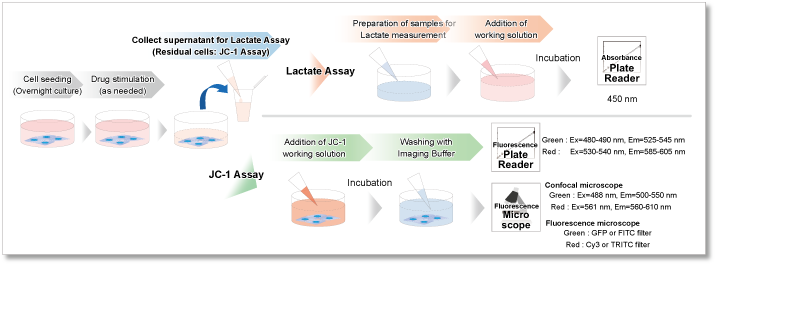
Experiment Example: Intracellular metabolic changes in HeLa cells treated with the glycolytic inhibitor 2-Deoxy-D-glucose (2-DG)
When we evaluated cell viability in 2-DG-treated HeLa cells using the CCK-8* assay, we observed minimal changes in viability. However, given the observed decrease in lactate production, it prompted us to question how cell viability was maintained in spite of glycolytic system inhibition. To answer this, we examined the mitochondrial membrane potential using the JC-1 Assay. The results from this investigation suggest that HeLa cells preserve their survival by boosting mitochondrial function when the glycolytic system is inhibited by 2-DG.
※ Cell Counting Kit-8 (product code: CK04) is not included in this kit.
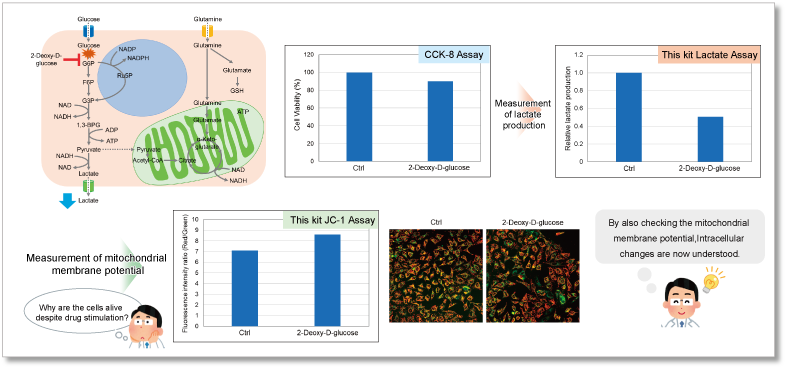
Q & A
-
Q
How many samples can be tested by this kit?
-
A
The number of samples that can be measured is shown in the table below, assuming that each independent sample is measured in triplicate.
(Lactate Assay)No need for preliminary experiments Need for preliminary experiments 96 well plate 48 well 39 well Number of samples
16 samples 13 samples *If the lactate concentration of the sample is unknown, perform a preliminary experiment to determine the dilution factor so that the absorbance is less than that of the 1 mmol/L lactate standard solution. Refer to "Sample preparation" in the instruction manual.
*The maximum number of samples that can be measured without a preliminary experiment or with a preliminary experiment.
*When performing the Lactate Assay, if the medium contains serum, it is recommended that a test sample be prepared only from the medium containing the serum used as the background control.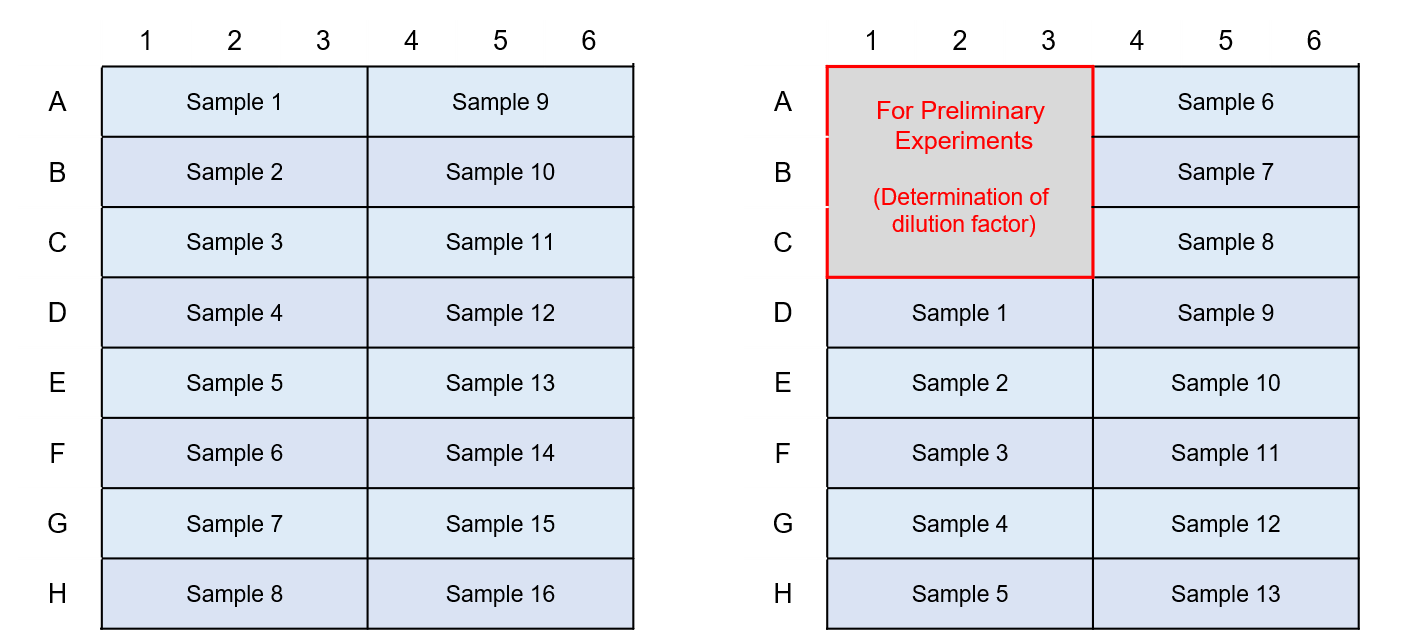
Plate Layout for the Lactate Assay (n=3)
(Left: without preliminary experiment, Right: with preliminary experiment)(JC-1 Assay)
adherent cells floating cells Culture Equipment
(Amount of JC-1
working solution)6 well
(1 ml/well)96 well
(50 μl/well)ibidi 8 well plate
(100 µl/well)35 mm dish
(1 ml/well)1.5 ml microtube
(0.25 ml/tube)Number of samples
to be measured3 samples 20 samples
(n=3)4 plates 3 samples 15 samples This kit contains JC-1 Assay reagents for 48 wells of 96-well microplates.
-
Q
How long does it take to perform the Lactate Assay and JC-1 Assay using this kit?
-
A
The experimental procedure and approximate time required for each assay is shown in the figure below.
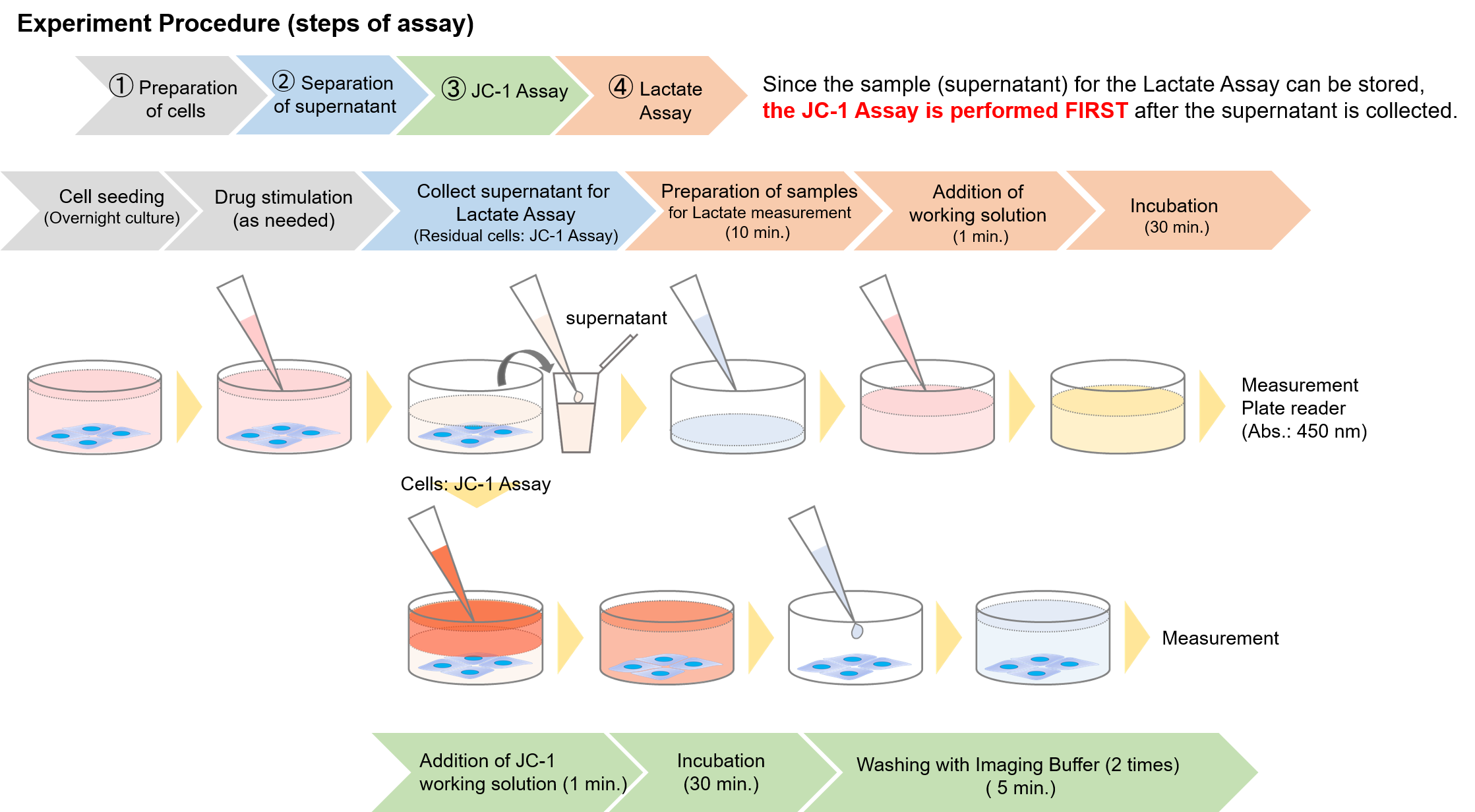
-
Q
Can I perform the Lactate Assay first and then the JC-1 Assay?
-
A
If the lactate assay is performed first, the difference in measurement time may affect the results depending on the stimulation conditions. Be sure to perform the JC-1 assay first after collecting the supernatant. Cell culture supernatants can be stored frozen (-20°C) for up to 1 month.
-
Q
[Lactate Assay] I do not have a 450 nm filter. What other filters can I use?
-
A
You can use filters with an absorbance between 450 nm and 490 nm. However, the absorbance value can become lower if the sample is not measured at 450 nm.
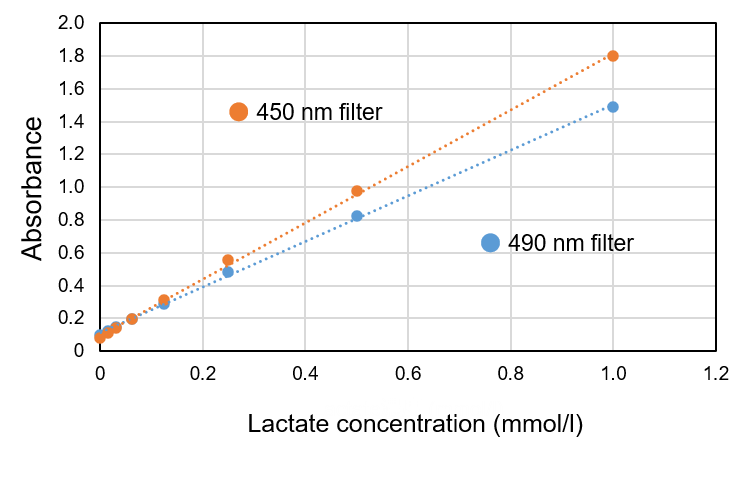
-
Q
[Lactate Assay] Can I measure samples that contain a reducing agent?
-
A
You can’t measure an accurate Lactate level because WST dye interferes with the reducing agent. If you add test material which possesses reducing properties, please prepare a few wells that only contain the medium without cells and only test material for background control. Please subtract the background from the absorbance of standard curve or samples.
-
Q
[Lactate Assay] How stable is the working solution?
-
A
You can’t store the Working solution. Please prepare the Working solution prior to use. Please protect from light because the Working solution is light-sensitive. The Working solution is stable for 4 hours at room temperature with protection from light.
Once the Working solution is exposed to light, the color of the solution becomes from red to orange. It caused to increase background.
-
Q
[Lactate Assay] Can cell culture supernatant samples be stored?
-
A
Can be stored frozen (-20°C) for one month.
-
Q
[JC-1 Assay] Can I use medium with serum?
-
A
Serum-containing medium can be used for cell washing and preparing JC-1 working solution. For fluorescence observation, we recommend the use of Imaging Buffer solution, but if serum-containing medium is used, phenol red-free medium is recommended.
-
Q
[JC-1 Assay] Is it possible to fix the cells?
-
A
Fixation is not recommended because the JC-1 dye does not work well due to mitochondrial depolarization.
-
Q
[Lactate Assay] The absorbance value of the sample is not different from that of the medium only (blank). What causes this and how does it get solved?
-
A
The cause may be that the amount of lactic acid released from the cells is low. Please increase the number of cells to be seeded or extend the incubation time further.
-
Q
[JC-1 Assay] Both red and green fluorescence values increased (or decreased). How should I interpret the results?
-
A
Calculate the ratio of red fluorescence value/green fluorescence value for each of the drug-treated samples and the control. The lower the fluorescence ratio, the lower the mitochondrial membrane potential.
(Reason for evaluating by red/green ratio)
Since JC-1 accumulates in cells in a membrane potential-dependent manner, the concentration of JC-1 per cell may differ depending on the cell condition1), 2) (the accumulation concentration of JC-1 is different between control and drug-treated samples due to the different cell conditions).
In addition, JC-1 aggregates and shifts its fluorescence from green to red when the mitochondrial membrane potential is high. The amount of this aggregation depends on the degree of membrane potential3), allowing comparison of mitochondrial membrane potential between samples in terms of the red/green ratio.
[Reference]
1) A. Cossarizza, et al., Biochem Biophys Res Commun. 1993, 197(1), 40.2) A. Perelman, et al., Cell Death and Disease, 2012, 3, e430.
3) S. T. Smiley, et al, Proc. Nail. Acad. Sci. 1991, 88, 3671.
-
Q
Can I order the product with a larger unit size?
-
A
Glycolysis/JC-1 MitoMP Assay Kit is a combined product of Lactate Assay Kit-WST (product code: L256) and JC-1-MitoMP Detection Kit (Product Code: MT09).
Please order these single products in combination for the larger unit size.Please note that the components themselves of these products are the same, although some component names in the L256 appear slightly different from this combined product.
product Glycolysis/JC-1 MitoMP Assay Kit Lactate Assay Kit-WST component name LDH Solution Enzyme Solution Lactate Assay Buffer Assay Buffer
Handling and storage condition
| 1. Store at 0-4℃; 2. Protect from light |









